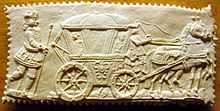Springerle

Springerle is a type of German biscuit with an embossed design made by pressing a mold onto rolled dough and allowing the impression to dry before baking. This preserves the detail of the surface pattern. They are most commonly seen during the Christmas season.
The name springerle means "little jumper" or "little knight". Their origin can be traced back to at least the 14th century in southwestern Germany and surrounding areas, mostly in Swabia.
Baking process
-

Raw springerle dough, just out of the wooden wedding-carriage mold (shown below).
-

Springerle dough after drying for a day.
-

Baked springerle, showing typical "foot".
The major ingredients of Springerle are eggs, white (wheat) flour, and very fine or powdered sugar. The biscuits are traditionally anise-flavored, although the anise is not usually mixed into the dough; instead it is dusted onto the baking sheets so that the biscuit sits on top of the crushed anise seeds.
Traditional Springerle recipes use hartshorn salt (ammonium carbonate, or baker's ammonia) as a leavening agent. Since hartshorn salt can be difficult to find, many modern recipes use baking powder as the leavening agent. Springerle made with hartshorn salt are lighter and softer than those made with baking powder. The hartshorn salt also imparts a crisper design and longer shelf-life to the Springerle. To make Springerle, very cold, stiff dough is rolled thin and pressed into a mold, or impressed by a specialized, carved rolling pin. The dough is unmolded and then left to dry for about 24 hours before being baked at a low temperature on greased, anise-dusted baking sheets.
The leavening causes the biscuit to at least double in height during baking. This "pop-up" effect may be the source of the name in German, and produces the characteristic "foot" along the edges, below the molded surface.
The baked biscuits are hard, and are packed away to ripen for two or three weeks. During this time, they become tender.
Molds
Molds are traditionally carved from wood, although plastic and pottery molds are also available. Pear wood is prized for its density and durability. Older handmade molds are folk art and are typically unsigned and undated.
The stamping technique may be derived from the molds used in some Christian traditions to mark sacramental bread, and the earliest molds featured religious motifs, including scenes from Bible stories and Christian symbols. Later, in the 17th and 18th century, heraldic themes of knights and fashionably dressed ladies became popular. Themes of happiness, love, weddings, and fertility remained popular through the 19th century.
-

Springerle mold from the Landesmuseum Württemberg
-

This mold shows a wedding carriage and many figures.
-

The back side of the same mold, showing more figures.
References
External links
| Wikibooks Cookbook has a recipe/module on |